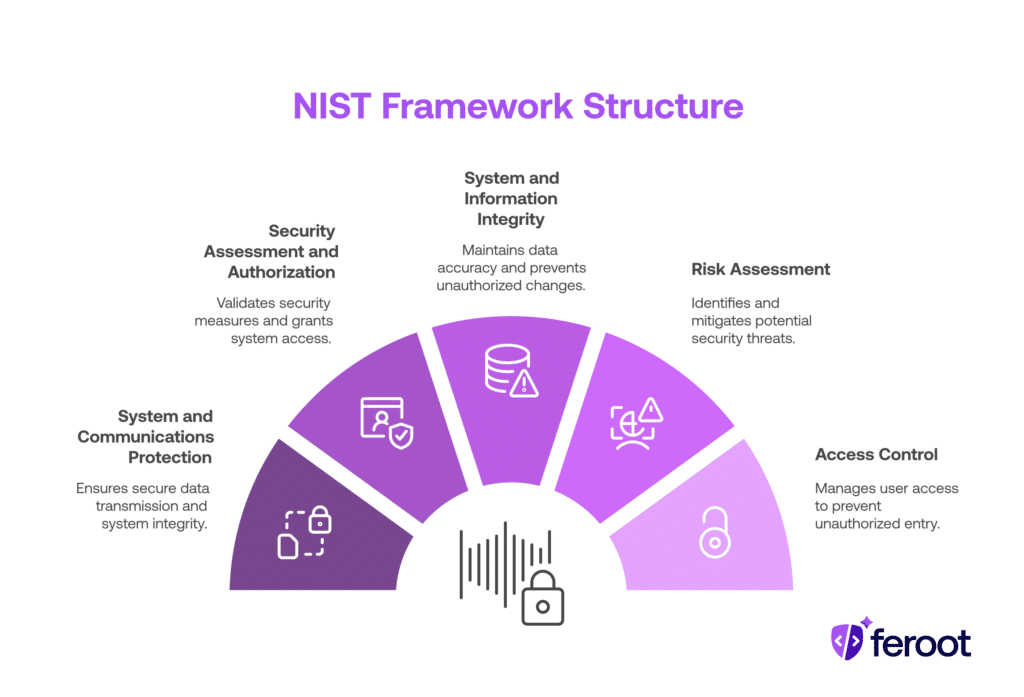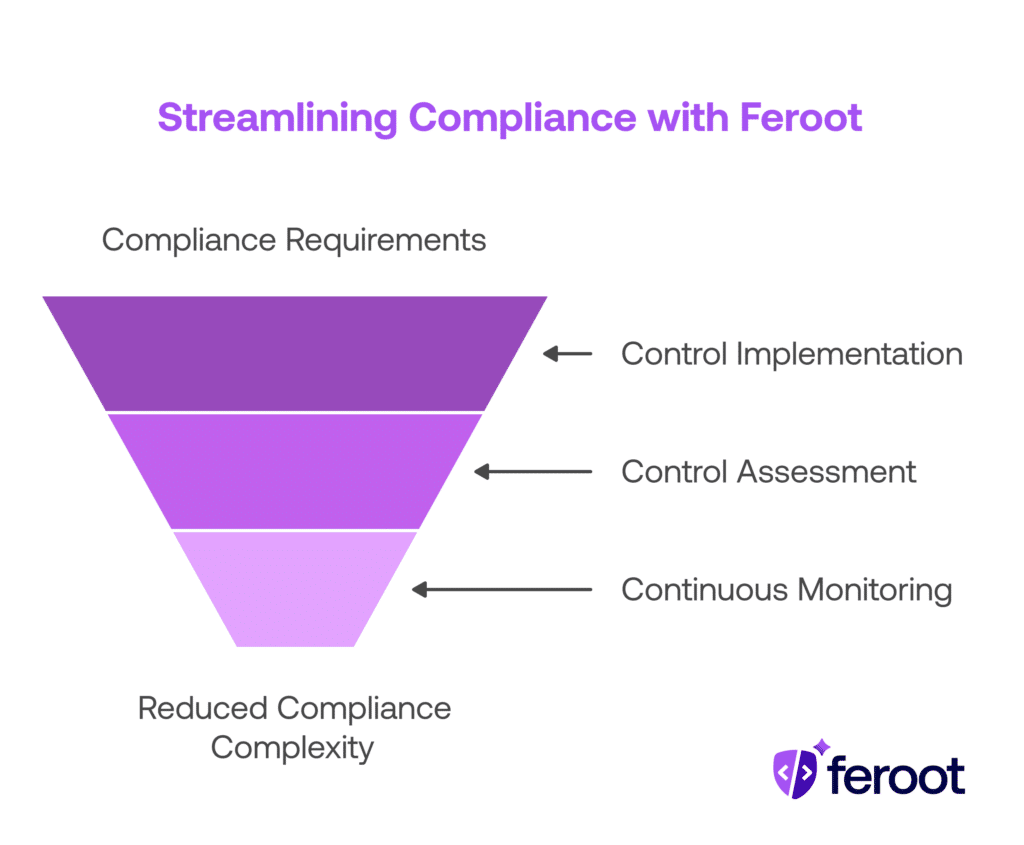TL;DR
- NIST SP 800-53 outlines baseline security controls for federal information systems, including web apps
- Modern web applications introduce client-side risks that many traditional tools don’t detect
- Compliance challenges often stem from lack of visibility into third-party scripts, browser behavior, and shadow code
- Meeting controls like SI-4, SC-7, and CA-7 requires continuous monitoring — not one-time assessments
- Solutions like Feroot help automate client-side security, map risks to NIST controls, and produce audit-ready evidence
What Is NIST SP 800-53?
NIST Special Publication 800-53 is a cybersecurity and privacy framework developed by the National Institute of Standards and Technology (NIST). It provides a standardized set of security controls for federal information systems, covering everything from access control and incident response to system monitoring and supply chain risk management.
The framework is organized into 20 control families, including:
- System and Communications Protection (SC)
- Security Assessment and Authorization (CA)
- System and Information Integrity (SI)
- Risk Assessment (RA)
- Access Control (AC)
NIST SP 800-53 is a core component of the NIST Risk Management Framework (RMF) and forms the foundation of compliance programs like FedRAMP and FISMA. It’s widely adopted beyond the public sector — by SaaS vendors, financial institutions, and critical infrastructure providers — to ensure a consistent, risk-based approach to cybersecurity.

Why is NIST SP 800-53 Critical for Federal Web Application Security?
NIST SP 800-53 is the gold standard for security and privacy controls in U.S. federal information systems. If your organization handles government data, builds FedRAMP-authorized platforms, or follows the NIST Risk Management Framework (RMF), compliance with 800-53 isn’t optional — it’s foundational.
But NIST SP 800-53 was designed before the modern, client-side-heavy web. As more business logic shifts to the browser, many risks now originate from:
- Third-party JavaScript libraries
- Tag managers injecting tracking pixels
- Shadow code and browser-side misconfigurations
- Lack of visibility into front-end behavior
Legacy tools don’t monitor this layer. That’s where Feroot comes in.
Which NIST Controls Are Hardest to Meet for Modern Web Apps?
Security leaders often struggle to meet NIST controls related to dynamic content, external scripts, and runtime protections — especially on the client side.
Some of the most challenging NIST SP 800-53 controls for web apps include:
- SI-10 (Information Input Validation): Ensuring all user input and dynamic content is properly checked
- SI-4 (System Monitoring): Monitoring system behavior in real time, including browser-side execution
- SC-7(10) (Boundary Protection – Web App Isolation): Preventing unauthorized communication between web components
- CA-7 (Continuous Monitoring): Ongoing assessment of security control effectiveness
- RA-5 (Vulnerability Scanning): Identifying and mitigating risks introduced via third-party scripts
The common problem? These controls require visibility into how the application behaves in users’ browsers, not just on the backend or cloud infrastructure.
How Does Feroot Automate Client-Side Compliance with NIST SP 800-53?
Feroot provides purpose-built tools for client-side security, enabling teams to monitor and enforce NIST SP 800-53 controls across browser environments.
Key Capabilities:
- Real-Time JavaScript Threat Detection: Feroot scans and monitors scripts executing in the browser for malicious behavior, insecure communications, and privacy violations
- Policy Enforcement for Web Components: Apply NIST-aligned security policies that restrict third-party code execution, enforce allowed domains, and detect unauthorized behavior
- Visual Mapping to NIST Controls: Feroot maps findings to specific NIST SP 800-53 controls, including SI-10, SI-4, CA-7, and more
- Audit-Ready Reporting: Export logs and compliance reports showing how client-side risks are mitigated in line with NIST requirements
- Continuous Monitoring: Always-on scanning that surfaces new risks without manual checks or test scripts
What Security Outcomes Do Teams Achieve with Feroot?
Organizations using Feroot to meet NIST SP 800-53 requirements for web apps have reported:
- Up to 90% reduction in manual evidence collection time
- Elimination of blind spots in browser-side security posture
- Improved audit readiness for FedRAMP, FISMA, and internal NIST RMF assessments
- Reduced risk of data leakage via unauthorized scripts or shadow code
How Does Feroot Align with NIST RMF and FedRAMP Workflows?
If your team is operating under NIST RMF or preparing for FedRAMP authorization, Feroot streamlines several key steps:
- Control Implementation (Step 3): Apply browser-side protection policies aligned with SI, SC, CA, and RA families
- Control Assessment (Step 4): Share Feroot’s audit-ready reports with your assessor or 3PAO
- Monitoring (Step 6): Automate continuous monitoring of client-side code without manual effort
Feroot fits seamlessly into existing GRC and DevSecOps workflows, reducing both the cost and complexity of maintaining compliance across app releases.

How Does Feroot Help Security Teams Meet NIST SP 800-53 Controls for Web Apps?
Feroot closes the gap most compliance tools miss — the browser layer.
Why this matters:
Most NIST controls assume visibility into the full application stack. But client-side scripts can introduce data exfiltration risks, privacy violations, and compliance failures without triggering alerts in backend systems.
Feroot ensures this layer is protected and aligned with key NIST control requirements:
- SC-7(10): Enforces web app boundaries to prevent unauthorized client-side communication
- SI-10 / SI-4: Detects and mitigates unvalidated script execution and third-party risk
- CA-7: Continuously monitors controls for effectiveness and provides alerting
- RA-5: Acts as a vulnerability scanner for browser-side risks
FAQ
How does client-side monitoring support NIST SP 800-53 compliance?
Many NIST controls depend on monitoring runtime behavior — which includes browser-side actions. Feroot provides the necessary visibility and enforcement at the client layer.
Can Feroot help with FedRAMP or FISMA audits?
Yes. Feroot produces audit-ready evidence and supports security control families used in both frameworks.
Does Feroot integrate with existing security tools?
Absolutely. Feroot integrates with SIEMs, DevOps pipelines, ticketing systems, and cloud platforms like AWS and Azure.
Is Feroot approved for use in regulated environments?
Feroot is used by security teams operating under NIST RMF, FedRAMP, HIPAA, PCI DSS, and other regulated standards.
What makes Feroot different from traditional appsec tools?
Feroot focuses specifically on client-side security — the browser layer most other tools ignore — which is critical for meeting NIST web app controls.
Conclusion: Shift from Manual Audits to Automated Client-Side Control Monitoring
NIST SP 800-53 compliance for web apps doesn’t stop at firewalls and cloud controls. It extends to the browser — where sensitive data can leak via overlooked scripts and third-party tools.
Feroot helps CISOs and compliance teams:
- Gain full visibility into client-side code risks
- Automate enforcement of key NIST controls
- Deliver audit-ready evidence for SI, SC, RA, and CA control families
- Stay aligned with RMF and FedRAMP workflows


